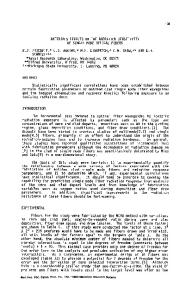Effects of radiation on SiC-based Nicalon fibers
- PDF / 3,330,800 Bytes
- 12 Pages / 583 x 792 pts Page_size
- 62 Downloads / 371 Views
M. Osbome Rensselaer Polytechnic Institute, Troy, New York 12180
K. L. More Oak Ridge National Laboratory, Oak Ridge, Tennessee 37831-6087 (Received 3 August 1994; accepted 11 November 1994)
This paper presents neutron and ion radiation effects in the Nicalon SiC polymer precursor fiber. It is shown that the serious structural degradation of this fiber and its composites (e.g., CVD SiC/Nicalon) previously reported for the standard grade of Nicalon is primarily due to the presence of the silicon oxycarbide phase. Results supporting this interpretation include microstructural analysis as well as post irradiation mechanical property measurements. Preliminary results of the effects of irradiation on low-oxygen Nicalon fibers are presented. The reduced oxygen content fibers exhibit radiation-induced density, strength, and Weibull's and Young's moduli changes typical of monolithic ceramic materials. This contrasts sharply with the poor irradiation behavior of the standard Nicalon fiber and suggests that improved radiation resistance can be expected in SiC/SiC composites fabricated with low oxygen Nicalon fibers.
I. INTRODUCTION The potential benefits of using ceramics in fusion power reactors have long been apparent. Their inherently low radioactivity and afterheat are benefits for maintenance and disposal, their potentially high operating temperatures offer the possibility of increased thermal efficiencies, and the unusually high modulus and strength of some ceramics make them attractive as structural materials. However, ceramics are inherently brittle, which raises many practical objections to their use. The use of silicon carbide (SiC) composites as structural materials in fusion systems has recently been considered mainly due to the development of high strength, continuous SiC fibers.1 Such fibers can be woven in various architectures and the preforms infiltrated with a SiC matrix by various methods, yielding a composite with reported2 bending strengths as high as 600 MPa. Another very attractive feature of these materials is that a degree of toughness can be designed into the composite by the application of a compliant interfacial layer between fiber and matrix. This layer allows the load to be transferred from the matrix to the high strength fiber and allows debonding to promote fiber pullout and crack bridging, which are two key mechanisms responsible for the composite's improved toughness. Silicon carbide fibers are commercially processed through many different routes. A summary of the properties of the fibers to be discussed is given in Table I. The most common route is by decomposition of a polymer precursor material and will be discussed more fully later. 736
J. Mater. Res., Vol. 10, No. 3, Mar 1995
A second, common commercial SiC fiber is (Textron SCS-6)3 processed by chemically vapor depositing SiC onto a pitch carbon core. The pitch carbon filament is 33 /i.m in diameter and the CVD SiC fiber is typically about 140 /jura in diameter. Due to the size of this fiber and consequently its stiffness, it is i
Data Loading...











